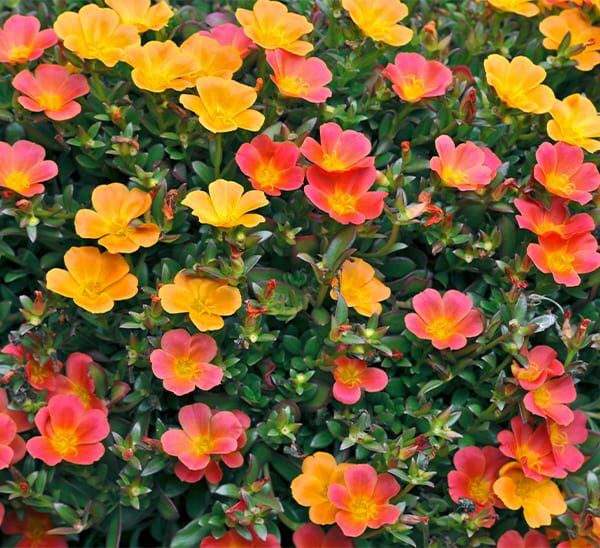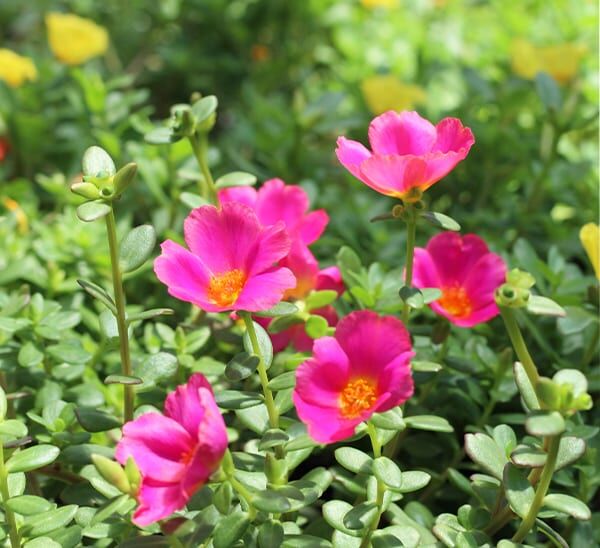Common Purslane
Bring instant impact to your flowerbeds & containers! Purslane will elevate your sunny Texas garden’s beauty with its stunning cup-shaped blooms and resilient, mounding growth. Create a picturesque landscape that’s sure to impress both you and your visitors.
Please contact your local store for product availability.
Find a garden center near you.
Species: Portulaca oleracea
Other Species Names: Common Purslane
Plant Height: 8 in.
Spread: 18 in.
Evergreen: No
Plant Form: Mounding
Minimum Sunlight: Full Sun
Maximum Sunlight: Full Sun
Purslane's allure lies in its vivid, cup-shaped blooms that span a spectrum of colors, from fiery reds to cheerful yellows. Its dense, mounding habit adds depth and dimension to garden beds and containers, creating a visually captivating landscape that thrives under the Texan sun.
Purslane has a dense, spreading habit and produces masses of flowers. It is an ideal choice for hanging baskets, containers, or as a unique ground cover in the landscape. With drought tolerance and dense growth, Purslane provides an attractive ground cover option while minimizing weed growth. It effortlessly enhances garden aesthetics while requiring minimal care.
Purslane loves our Texas summers! It prefers a sunny location with well-draining soil. Space the plants 6-8 inches apart, and water thoroughly after planting. Once established, Purslane is drought and heat tolerant. It grows as a dense, low mound, making it an excellent ground cover or adorning your hanging baskets.
How to Care for Common Purslane
Common Purslane thrives in full sun, needing at least 6–8 hours of direct sunlight daily. It loves heat and bright conditions, which encourage compact growth and abundant yellow blooms. While it can tolerate light shade, full sunlight produces the healthiest, most colorful plants.
Purslane prefers well-draining, sandy or rocky soil and grows well even in poor or dry ground. It doesn’t require rich soil and can thrive in spots where other plants struggle. Avoid heavy clay or waterlogged areas, as too much moisture can cause root rot.
Water sparingly—Purslane is a drought-tolerant succulent that stores moisture in its leaves. Water deeply only when the soil is completely dry. Overwatering can lead to rot or weak growth. In containers, check soil moisture occasionally, as pots can dry out faster in hot weather.
Purslane generally doesn’t need fertilizer. If your soil is extremely poor, use a light application of balanced fertilizer (like 10-10-10) once early in the growing season. Too much fertilizer promotes leaf growth over flowers, so minimal feeding is best.
Pruning isn’t usually necessary, but you can pinch back leggy stems to encourage fuller, bushier growth. Regular harvesting of leaves and stems also helps the plant stay compact and healthy. Removing spent flowers encourages new blooms.
Purslane is mostly pest- and disease-free, but aphids, mealybugs, or fungal spots can appear in overly damp conditions. Good drainage and proper spacing help prevent these issues.
No—Common Purslane is not frost-tolerant. It thrives in warm weather and will die back when temperatures drop below 40°F. Plant it after the last frost in spring and treat it as an annual in cooler climates.


